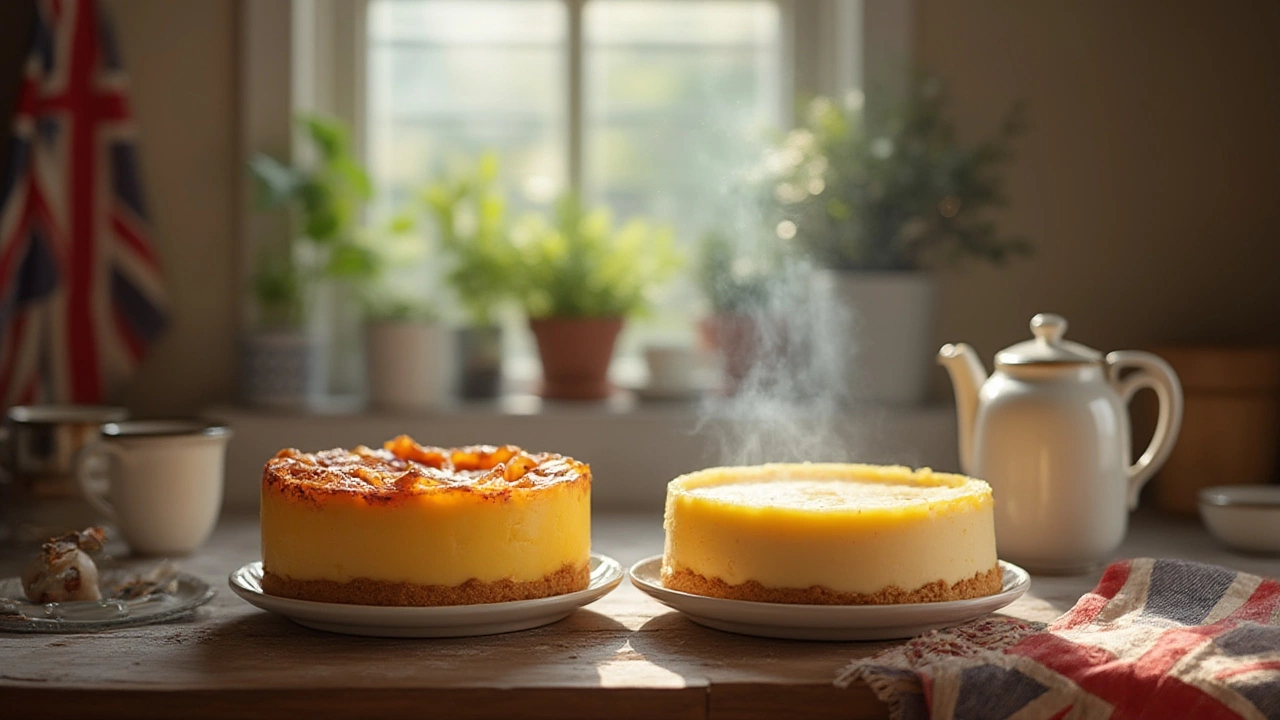
Walk into any café or bakery, and the glass display is likely to flaunt cheesecakes—some tall and golden, others pale and cloud-like, slices lined up like sweet soldiers. But have you ever taken a bite and wondered, why do some taste densely creamy, while others pretty much melt on your tongue? There’s a real split in the cheesecake world, and it all boils down to how they’re made. The baked cheesecake versus the continental cheesecake. This isn’t just a matter of oven versus fridge—it’s about texture, taste, tradition, and trust me, the debate between fans gets passionate. Let’s get right into what actually sets these two crowd-pleasers apart, and give you the kind of lowdown that’ll make you the star of any afternoon tea or dinner party conversation.
What Makes a Baked Cheesecake Unique
Baked cheesecake is a kind of hug disguised as dessert. It’s rich, velvety, and it starts with beating together cream cheese, sugar, and eggs, sometimes adding a good dollop of sour cream or heavy cream for silky smoothness. This mixture gets poured over a crumbly biscuit base—classic New York cheesecakes often use graham crackers, while Italians lean on crushed amaretti or even sponge.
The real magic happens in the oven. Baked cheesecakes are gently cooked—typically in a water bath or low, slow heat, which lets them set without cracking or going dry. This slow bake gives that dense but soft texture, nowhere near as airy as some desserts, but definitely not rubbery. When you slice into it, you get a creamy wedge that stands proud on a fork, with a cool smoothness and an unmistakable cheesiness that’s not overly sweet.
Temperature matters, too. Most recipes suggest baking until there’s just a hint of wobble in the middle—the jiggle test. Overbake and you’ll get a dry, crumbly bite. Underbake and you risk a collapsed center. The flavor develops as it cools, and most aficionados swear by chilling the cake for at least four hours, if not overnight. It’s a little lesson in patience, but the wait is worth it.
Let’s throw in some numbers: an iconic New York-style baked cheesecake uses nearly a kilogram of cream cheese for a single cake. Eggs are crucial—no eggs, no rich custard taste. Famous food scientist Harold McGee points out in his classic book, On Food and Cooking, that “the egg protein coagulates as the cheesecake bakes, transforming the loose batter into a firm but tender, sliceable delicacy.”
"A true baked cheesecake showcases the harmony of simple, careful technique and just a handful of good ingredients." — The Kitchn
How about toppings? Baked cheesecakes are basically a blank canvas. You’ll see them crowned with tangy berry compotes, zesty citrus sauces, or even swirls of caramel. You’ll notice, too, they hold up well—perfect for slicing at fancy afternoon teas or bringing along to a friend’s birthday bash.
For those who crave fun facts: Baked cheesecakes aren’t as ancient as people think. While the Greeks had honey-sweetened cheese cakes, the classic baked cheesecake as we know it only became a dessert staple in twentieth-century America, mostly thanks to Philadelphia cream cheese (which hit the market in 1872, but really caught on during the roaring twenties).
Here’s a quick tip: always bring baked cheesecake to room temperature for about 20 minutes before serving. Straight-from-the-fridge tends to dull both flavor and creaminess, and nobody wants a cold brick for dessert. And remember, when properly wrapped, these beauties freeze like a dream—just avoid freezing with fruit toppings as they can go a little mushy.

The Secret Life of Continental Cheesecake
Picture this: a cheesecake that never sees the inside of an oven. Continental cheesecake is set in the fridge, relying on chilled magic, not heat. This variation is soft, light, almost mousse-like, and feels a little less sinful on the waistline—at least until you notice the calories in the cream!
The base here usually starts the same way: crushed biscuits mixed with melted butter, pressed into a pan to chill and harden. But the filling is where things really stray from the baked version. Cream cheese still plays the main role, but eggs are usually left out. Instead, you mix in whipped cream, sometimes a little Greek yogurt or mascarpone, and a bit of sugar. Gelatin is the real hero—it sets the filling while it cools, creating that shiver-inducing, delicate wobble that’s so easy to mistake for panna cotta. One London food stylist puts it like this: “Continental is the cheesecake for folks who hate fuss, love a trifle, and want something dreamy to finish a summer barbecue.” No baking, no risk of cracks or water baths, no long cooling—just whisk, pour, chill, and slice. The fridge does the heavy lifting.
Gelatin is key, but it can mess things up if you move too quickly. Ever had a cheesecake that split into layers, or where the top seems too rubbery? That’s usually from slapdash gelatin work, or trying to set it before all the lumps vanish. Most chefs recommend blooming the gelatin in a bit of water, melting it gently, then folding it slowly through the cream cheese and whipped cream mix. Go slowly, and you’ll get a filling that’s smooth with just a gentle bounce.
The flavor of continental cheesecakes is on the lighter side. No eggy custard undercurrent. They are often sweeter and carry the tang of lemon juice or zest—perfect for soaking up and balancing fruit toppings. They’re a summer party favorite in Australia, New Zealand, and the UK. If you spot a passionfruit or mango cheesecake in a café down under, odds are, it’s continental.
This style is great for adding funky flavors without the risk of them going weird in the oven—think coffee, matcha, white chocolate, or layers of fresh berries. Because you’re not heating anything past room temp, color and texture stay really vibrant. The top tip from pro bakers: line your pan with acetate or parchment, so those slices come out perfectly neat, and always chill overnight if you want a mighty clean cut.
It’s not all roses, though. Continental cheesecakes can soften fast at room temperature, so don’t expect them to sit on a party table for hours. And if you’ve got vegetarian guests, remember that classic gelatin is animal-based—swap for agar or a plant-based thickener if needed.

How To Choose: Baked or Continental Cheesecake?
So, when you’re about to make or buy a cheesecake, what type will work best? It boils down to what you want from your dessert: weight and richness, or dreamy lightness?
Baked cheesecake delivers that classic flavor—creamy, tangy, with a dense texture that feels indulgent but sophisticated. It holds up well to transport and can handle all sorts of toppings and flavor twists. If you love things a bit on the traditional side, or you crave that classic cheesecake thickness after dinner, you’re probably in the baked camp. Just keep in mind the baking process: cracking is normal (don’t panic), but gentle cooling and baking in a water bath can help keep the top smooth and silky. And be ready to wait: a proper baked cheesecake needs cooling and chilling to really set.
Continental cheesecake, on the other hand, is the go-to for effortless entertaining or hot weather. It needs almost no technical skill—just blending, folding, pouring, and chilling. The result is lighter, fresher, and usually a touch sweeter. It shines with fruity flavors and creamy toppings that wouldn’t always survive the oven. Just remember, if you’re feeding a crowd, keep the cake cold until just before serving.
If you’re unsure which to make, here’s a quick list to help you decide:
- If you love creamy density and a slightly tangy aftertaste, go baked.
- If you’re looking for light, mousse-like texture, skip the oven and chill a continental.
- If you have vegan or gluten-free guests, it’s easier to adapt continental cheesecakes—use a dairy-free spread, coconut cream, or agar for thickening.
- If decorating is your goal (layers, swirls, patterns), continental keeps everything crisp and colorful, since nothing melts or browns.
- If you want to prep ahead and freeze, baked cheesecakes hold up best.
Baking legend Dorie Greenspan says:
"Cheesecake is a test of patience and technique, but the results—whether baked or unbaked—are always worth the wait."
One parting tip that nearly all pro bakers swear by: use room-temperature ingredients (cream cheese, creams, eggs, and butter). It makes the mixing smoother, knocks out lumps, and ensures you get the creamiest possible result, whether you’re baking or setting your masterpiece in the fridge. And always taste your filling before loading it into the shell. A single splash of lemon or an extra spoonful of sugar can make all the difference.
So next time that dessert craving hits, think about what you’re in the mood for—decadent, old-school luxury, or something that floats off your fork. Whichever cheesecake you pick, you’ll have a creamy slice of happiness waiting at the end.